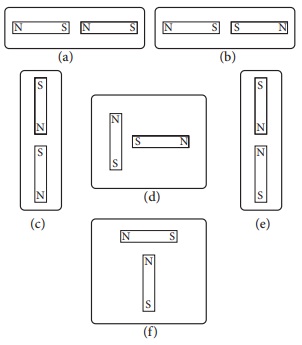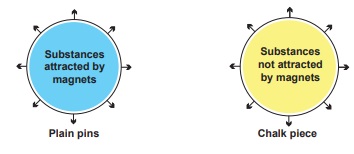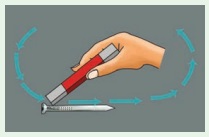Magnetism | Term 3 Unit 1 | 6th Science - Questions Answers | 6th Science : Term 3 Unit 1 : Magnetism
Chapter: 6th Science : Term 3 Unit 1 : Magnetism
Questions Answers
Evalution
I. Choose the appropriate answer
1. An object that
is attracted by magnet.
a. wooden piece
b. plain pins
c. eraser
d. a piece of paper
Answer: b) plain pins
2. People who made mariner’s compass for the
first time.
a. Indians
b. Europeans
c. Chinese
d. Egyptians
Answer: c. Chinese
3. A freely suspended magnet always comes to
rest in the _____________ direction
a. North – east
b. South - west
c. East - west
d. North – south
Answer: d. North - south
4. Magnets lose their properties when they are
a. used
b. stored
c. hit with a
hammer
d. cleaned
Answer: c. hit with a hammer
5. Mariner’s compass is used to find the
a. speed
b. displacement
c. direction
d. motion.
Answer: c. direction
II. Fill in the Blanks
1. Artificial
magnets are made in different shapes such as bar, horseshoe and ring.
2. The Materials
which are attracted towards the magnet are called magnetic substances.
3. Paper is not a magnetic material.
4. In olden days,
sailors used to find direction by suspending a piece of magnet (lodestone).
5. A
magnet always has two poles.
III. True or False. If False, give the correct
statement
1. A cylindrical
magnet has only one pole.
A cylindrical magnet
has two poles.
2. Similar poles of
a magnet repel each other.
3. Maximum iron
filings stick in the middle of a bar magnet when it is brought near them.
When a magnet is brought
near iron filings maximum iron filings stick to the poles.
4. A compass can be
used to find East- West direction at any place.
A compass shows north-south
directions. Stretch your left hand towards north and your right hand towards south.
The direction in front of our face is east and the direction at our back is west.
5. Rubber is a
magnetic material.
Rubber is not attracted
by magnet It is a non-magnetic material.
IV. Match the following
1. Compass –
Maximum magnetic strength
2. Attraction - Like
poles
3. Repulsion - Opposite
poles
4. Magnetic poles -
Magnetic needle
Answer:
1. Compass - Magnetic needle
2. Attraction - Opposite poles
3. Repulsion - Like poles
4. Magnetic poles - Maximum
magnetic strength
V. Circle the odd ones and give reasons
1. Iron nail, pins,
rubber tube , needle.
Iron nail, pins, (rubber tube), needle.
Reason: Rubber
tube is a non-magnetic material. Others are magnetic materials.
2. Lift, escalator,
electromagnetic train, electric bulb.
Lift, escalator, electromagnetic
train, (electric bulb)
Reason: Magnets are not used in an electric bulb but the other devices make
use of magnets.
3. Attraction,
repulsion, pointing direction, illumination.
Attraction, repulsion, pointing direction, (illumination)
Reason: Illumination is not a property of a magnet. Others are magnetic
properties.
VI. The following diagrams show two magnets near one
another. Use the words, 'Attract, Repel, Turn around' to describe what happens
in each case.

Answer:
a) Attract
b) Repel
c) Attract
d) Turn around
e) Repel
f) Turn around
VII. Write down the names of substances.


VIII. Give short answer
1. Explain the attraction and repulsion between
magnetic poles.
Unlike poles (S-N, N-S) attract each other. Like Poles (N-N, S-S)
repel each other.
2 A student who checked some magnets in the
school laboratory found out that their magnetic force is worn out. Give three
reasons for that?
Magnets lose their properties if they are heated or dropped from
a height or hit with a hammer.
IX. Answer in detail
1. You are provided with an iron needle. How
will you magnetize it ?

Take the iron needle and place it on a table. Now take a bar magnet
and place one of its poles near one edge of the needle and rub from one end to another
end without changing the direction of the pole of the magnet. Repeat the process
for 30 to 40 times.
Bring a pin or some iron filings near the needle to check whether
it has become a magnet. Does the needle attract the pin / iron filings? If not,
continue the same process for some more time.
2 How does the electromagnetic train work?
Electromagnets are used in Electromagnetic trains. Electromagnets
are magnetised only when current flows through them. When the direction of current
is changed the poles of the electromagnets are also changed. Like poles of the magnets
which are attached at the bottom of the train and rail track repel each other. So,
the train is lifted from the track up to a height of 10 cm.
We know that we can move any magnetic object with the force of attraction
or repulsion properties of magnets. This train also moves with the help of the magnets
attached on the sides of track and the magnets fitted at the bottom sideway of the
train. By controlling the current we can control the magnets and movement of the
train.
X. Questions based on Higher Order Thinking
Skills
1. You are provided with iron filings and a bar
magnet without labelling the poles of the magnet. Using this...
a. How will you identify the poles of the
magnet?
The given bar magnet is suspended by a thread. The bar magnet comes
to rest in a particular direction. The end of the magnet that points the north is
marked as North Pole. The other end which points to the south is marked as South
Pole.
b. Which part of the bar magnet attracts more
iron filings? Why?
We should place the bar magnet on the iron filings kept on paper.
We should turn the magnet on the iron filings a few times. We find that the ends
of the magnets (poles) attract more iron filings. This is because the magnetic force
is very strong only at the poles of a magnet.
2. Two bar
magnets are given in the figure A and B. By the property of attraction,identify
the North pole and the South pole in the bar magnet (B)


3. Take a glass
of water with a few pins inside. How will you take out the pins without dipping
your hands into water?
Tilt the glass slightly without spilling the water. Hold the pole
of a bar magnet close to the pins, outside the glass. Some pins will stick to the
magnet outside. Drag the magnet to the surface of water close to the glass. When
the pins are dragged out of the water surface we can pick them up. By repeating
this process we can take all the pins out without dipping our fingers in the water.
Related Topics